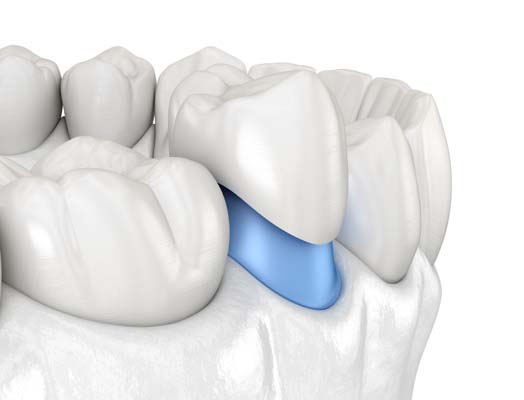How Does a Dentist Prepare a Tooth for a Dental Crown?

A dental crown is a cap used to completely cover back moral teeth. The process of having a crown placed is quite simple, but there are a few key preparation steps that a dentist must take first.
The preparation steps for getting a dental crown
Outlined here are the steps that a dentist takes to prepare a tooth for a dental crown. Review this information when preparing for an upcoming appointment.
First and foremost, the dentist will numb the patient using a local anesthetic. This is necessary because it helps prevent the patient from feeling any pain or discomfort.
1. Damage removal
The first step that a dentist takes in preparing a tooth for a dental crown is to remove any damaged or decayed areas. A dental drill is used to carefully do this. Although it sounds painful, the dentist does ensure that proper numbing has been done to eliminate any discomfort. Having damaged or decayed areas removed is crucial in restoring the health of the tooth and surrounding areas.
2. Cleaning
Next, the dentist cleans out the tooth. In most cases, the removal of damage or decay will result in empty spaces, even if they are small. Because these empty spaces are susceptible to bacteria growth, it is essential that they are thoroughly cleaned out and disinfected.
3. Filling
Once the tooth has been cleaned out, the dentist will fill any empty spots with a dental material called gutta-percha. This material is 100% safe for the teeth and mouth. It is used to keep bacteria out of the tooth, which eliminates any potential for new infections.
4. Smoothing
The final step in tooth preparation is for the dentist to smooth the surfaces of the tooth. Often, a decayed or damaged tooth is rough to the touch or has areas that are sharp, which could put the rest of the mouth at risk of being scraped or cut. To smooth out the surfaces, the dentist will use instruments to shave down certain areas. The numbing agent provided at the start of the procedure will prevent any discomfort.
What happens next
After the dentist follows the preparation steps, the tooth will be ready for the temporary dental crown. From there, the patient returns home for a few weeks while waiting for the permanent dental crown to be ready.
The dentist advises patients to avoid eating anything too hard or sticky, as this could dislodge the dental crown and damage the freshly restored tooth.
Find out more
Individuals who want more information on what it is like to get a dental crown should consult directly with a general dentist. Any questions or concerns about the process can be addressed by the dentist, and an evaluation can be performed to get started. Reach out today to learn more or to get scheduled!
Request an appointment here: https://balmoraldentalcenter.com or call Balmoral Dental Center at (256) 429-3870 for an appointment in our Huntsville office.
Check out what others are saying about our dental services on Yelp: Dental Crown in Huntsville, AL.
Related Posts
A damaged dental crown can cause discomfort and disrupt the functionality of your teeth. Whether the crown has cracked, chipped, or fallen out, addressing the issue promptly is crucial for preserving your oral health. Dental crowns are designed to protect and restore damaged teeth, but taking the right steps can prevent further complications when they…
When a tooth needs to be restored, a dental crown is usually a great option. Restoring a tooth to good form involves the preparation of the tooth for the placement of the crown. Getting a crown is usually recommended because it can help restore your tooth to its normal shape, function, and look. Read on…
Patients who have damaged teeth might want to consider getting a dental crown. One of the benefits of a dental crown is that it can protect the tooth and prevent extraction from being necessary. There are many kinds of materials, such as metal or porcelain crowns. Patients can also look for more natural options, which…
When getting a dental crown, you might wonder how many visits you need to make before you can get the restoration. Usually, you can expect to have around two office visits to complete the process. There are several steps involved, so you might want to understand each one a bit better. Keep reading to learn…


